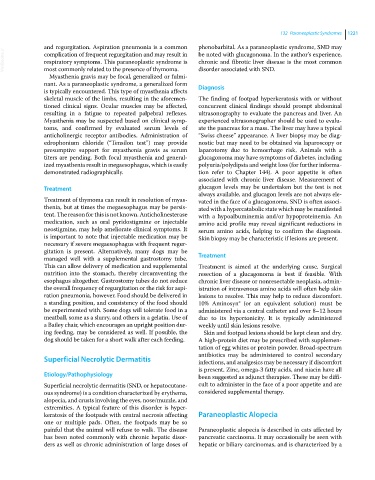Page 1283 - Clinical Small Animal Internal Medicine
P. 1283
132 Paraneoplastic Syndromes 1221
and regurgitation. Aspiration pneumonia is a common phenobarbital. As a paraneoplastic syndrome, SND may
VetBooks.ir complication of frequent regurgitation and may result in be noted with glucagonoma. In the author’s experience,
chronic and fibrotic liver disease is the most common
respiratory symptoms. This paraneoplastic syndrome is
most commonly related to the presence of thymoma.
Myasthenia gravis may be focal, generalized or fulmi- disorder associated with SND.
nant. As a paraneoplastic syndrome, a generalized form Diagnosis
is typically encountered. This type of myasthenia affects
skeletal muscle of the limbs, resulting in the aforemen- The finding of footpad hyperkeratosis with or without
tioned clinical signs. Ocular muscles may be affected, concurrent clinical findings should prompt abdominal
resulting in a fatigue to repeated palpebral reflexes. ultrasonography to evaluate the pancreas and liver. An
Myasthenia may be suspected based on clinical symp- experienced ultrasonographer should be used to evalu-
toms, and confirmed by evaluated serum levels of ate the pancreas for a mass. The liver may have a typical
anticholinergic receptor antibodies. Administration of “Swiss cheese” appearance. A liver biopsy may be diag-
edrophonium chloride (“Tensilon test”) may provide nostic but may need to be obtained via laparoscopy or
presumptive support for myasthenia gravis as serum laparotomy due to hemorrhage risk. Animals with a
titers are pending. Both focal myasthenia and general- glucagonoma may have symptoms of diabetes, including
ized myasthenia result in megaesophagus, which is easily polyuria/polydipsia and weight loss (for further informa-
demonstrated radiographically. tion refer to Chapter 144). A poor appetite is often
associated with chronic liver disease. Measurement of
Treatment glucagon levels may be undertaken but the test is not
always available, and glucagon levels are not always ele-
Treatment of thymoma can result in resolution of myas- vated in the face of a glucagonoma. SND is often associ-
thenia, but at times the megaesophagus may be persis- ated with a hypercatabolic state which may be manifested
tent. The reason for this is not known. Anticholinesterase with a hypoalbuminemia and/or hypoproteinemia. An
medication, such as oral pyridostigmine or injectable amino acid profile may reveal significant reductions in
neostigmine, may help ameliorate clinical symptoms. It serum amino acids, helping to confirm the diagnosis.
is important to note that injectable medication may be Skin biopsy may be characteristic if lesions are present.
necessary if severe megaesophagus with frequent regur-
gitation is present. Alternatively, many dogs may be
managed well with a supplemental gastrostomy tube. Treatment
This can allow delivery of medication and supplemental Treatment is aimed at the underlying cause. Surgical
nutrition into the stomach, thereby circumventing the resection of a glucagonoma is best if feasible. With
esophagus altogether. Gastrostomy tubes do not reduce chronic liver disease or nonresectable neoplasia, admin-
the overall frequency of regurgitation or the risk for aspi- istration of intravenous amino acids will often help skin
ration pneumonia, however. Food should be delivered in lesions to resolve. This may help to reduce discomfort.
a standing position, and consistency of the food should 10% Aminosyn® (or an equivalent solution) must be
be experimented with. Some dogs will tolerate food in a administered via a central catheter and over 8–12 hours
meatball, some as a slurry, and others in a gelatin. Use of due to its hypertonicity. It is typically administered
a Bailey chair, which encourages an upright position dur- weekly until skin lesions resolve.
ing feeding, may be considered as well. If possible, the Skin and footpad lesions should be kept clean and dry.
dog should be taken for a short walk after each feeding. A high‐protein diet may be prescribed with supplemen-
tation of egg whites or protein powder. Broad‐spectrum
antibiotics may be administered to control secondary
Superficial Necrolytic Dermatitis infections, and analgesics may be necessary if discomfort
is present. Zinc, omega‐3 fatty acids, and niacin have all
Etiology/Pathophysiology been suggested as adjunct therapies. These may be diffi-
Superficial necrolytic dermatitis (SND, or hepatocutane- cult to administer in the face of a poor appetite and are
ous syndrome) is a condition characterized by erythema, considered supplemental therapy.
alopecia, and crusts involving the eyes, nose/muzzle, and
extremities. A typical feature of this disorder is hyper-
keratosis of the footpads with central necrosis affecting Paraneoplastic Alopecia
one or multiple pads. Often, the footpads may be so
painful that the animal will refuse to walk. The disease Paraneoplastic alopecia is described in cats affected by
has been noted commonly with chronic hepatic disor- pancreatic carcinoma. It may occasionally be seen with
ders as well as chronic administration of large doses of hepatic or biliary carcinomas, and is characterized by a

